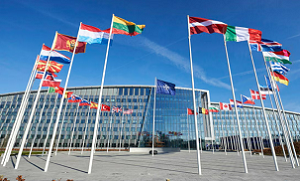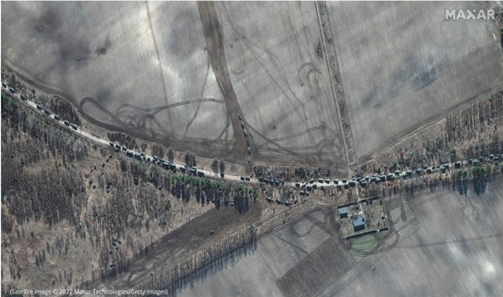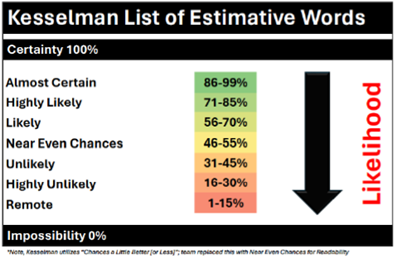[Editor’s Note: Regular readers of the Mad Scientist Laboratory are already familiar with the five domains associated with contemporary combat operations — land, sea, air, space, and cyberspace. When Russia launched its “Special Military Operation” into Ukraine in February 2022, the world watched as the Ukrainian Armed Forces absorbed and withstood the amassed might of the Russian Ground, Airborne, Naval, and Aerospace Forces arrayed against it. One integral aspect of Ukraine’s valiant defense was the role the private sector played in providing corroborative intelligence via space imagery, effective cyber security, and resilient Command and Control networks.
The Atlantic Council Scowcroft Center for Strategy and Security coined a new sobriquet — the “sixth domain” — to capture the private sectors’ contributions in contemporary combat operations. Today’s post by the U.S. Army War College’s Team Sullivan’s Travels member LTC Kristine M. Hinds assesses the importance of the sixth domain to future conflicts — especially in supporting coalition partners in geographically separated locations — Read on!]
Executive Summary
Private sector companies are highly likely (71-85%) to play a significant role in the success of future conflicts by 2027 and will require inclusion and consideration in war planning and preparation by friendly forces (Note: The Kesselman List of Estimative Words legend may be found at the conclusion of this blog post, above the disclaimer statement). This is due to private company involvement and support in cyber-defense, advanced imagery, and communication that will increase the ability to support partners and allies from geographically separated locations. Despite the lack of policies and procedures for applying private sector products and services, the United States and Western allies rely on the private sector for future success.
Discussion
The Russia-Ukraine War demonstrates the importance of private-sector companies during conflict. The Atlantic Council Scowcroft Center for  Strategy and Security labeled the private sector and their sphere of activities as a “sixth domain” for consideration in future war planning. Private sector companies provided significant capabilities such as cybersecurity, information technology, advanced imagery, and increased communication that enabled the Ukrainian continued defense. With the rapid and continued advancements in technology, Russia’s heightened frequency of cyber-attacks during the invasion resulted in minimal disruption. Ukraine’s cyber defense capabilities were successful due to the involvement of international private sector companies and partners for the “collective defense” of Ukraine. American tech companies Palo Alto and Microsoft contributed to safeguarding data and protecting Ukrainian networks by setting up firewalls, protecting critical infrastructure, and safeguarding Ukrainian data through migrating data to foreign servers. The British Foreign, Commonwealth and Development Office (FCDO) sponsored a program enabling Ukrainian agencies to access the services of commercial companies. This arrangement paved the way for the British government to use commercial cybersecurity capabilities when required.
Strategy and Security labeled the private sector and their sphere of activities as a “sixth domain” for consideration in future war planning. Private sector companies provided significant capabilities such as cybersecurity, information technology, advanced imagery, and increased communication that enabled the Ukrainian continued defense. With the rapid and continued advancements in technology, Russia’s heightened frequency of cyber-attacks during the invasion resulted in minimal disruption. Ukraine’s cyber defense capabilities were successful due to the involvement of international private sector companies and partners for the “collective defense” of Ukraine. American tech companies Palo Alto and Microsoft contributed to safeguarding data and protecting Ukrainian networks by setting up firewalls, protecting critical infrastructure, and safeguarding Ukrainian data through migrating data to foreign servers. The British Foreign, Commonwealth and Development Office (FCDO) sponsored a program enabling Ukrainian agencies to access the services of commercial companies. This arrangement paved the way for the British government to use commercial cybersecurity capabilities when required.
The continued impact by and requirement for private sector cybersecurity involvement will continue to increase through 2030. Cybersecurity is one of the fastest-growing professions and is projected to grow by 35 percent by 2031. Private-sector salaries are 20-35 percent higher than public sector, drawing a larger pool of talent. To compete and succeed in the cyber domain in 2030 and beyond, militaries will need to leverage the private-sector’s expansive talent and technology base.  The North Atlantic Treaty Organization (NATO) already recognizes the need for stronger integration with the private sector, as outlined in NATO 2030, through harnessing civilian innovation and engaging with academia.
The North Atlantic Treaty Organization (NATO) already recognizes the need for stronger integration with the private sector, as outlined in NATO 2030, through harnessing civilian innovation and engaging with academia.
Several tech companies provided other capabilities to Ukraine, such as satellite imagery and communication equipment. Amazon and Google assisted in migrating critical Ukrainian data to distributed cloud servers and providing technical support. Maxar Technologies provided satellite imagery at the onset of the invasion, showing a 64-kilometer Russian convoy headed to Kyiv. They continued to provide imagery disproving Russian claims and depicting the extent of damage across Ukraine. Other companies, such as Scale AI, provided images, free of cost, of recently bombed buildings and cities, allowing for accurate humanitarian and medical response to impacted areas. The commercial satellite imagery industry provides greater integration with allies and partners as these images are unclassified and can be freely shared. 2027 and beyond will require greater cooperation with partners and a variety of available information in a contested space domain. Private sector imagery will likely become critical during future conflicts to enhance flexibility, information sharing, and rapid decision-making.

The private sector, labeled the sixth domain, requires consideration and inclusion in warfighting plans in preparation for the U.S. and its allies to succeed in future conflicts. Private involvement is not without concern or issue. Without regulation, private companies make decisions that directly impact the outcome of a conflict. SpaceX, responsible for providing Starlink to  the Ukrainians, denied satellite internet service to prevent a Ukrainian drone from attacking a Russian naval fleet. This decision demonstrated the power of one individual — Elon Musk in this case — in directing the course of a specific engagement during a conflict. Private companies may continue to make decisions that shift the direction of a conflict as they fit their requirements or beliefs. Conversely, any over-regulation or government involvement may deter private-sector involvement altogether. To harness the private sector influence in 2027 and beyond, militaries must prepare for their involvement and include the impacts of the sixth domain in all planning.
the Ukrainians, denied satellite internet service to prevent a Ukrainian drone from attacking a Russian naval fleet. This decision demonstrated the power of one individual — Elon Musk in this case — in directing the course of a specific engagement during a conflict. Private companies may continue to make decisions that shift the direction of a conflict as they fit their requirements or beliefs. Conversely, any over-regulation or government involvement may deter private-sector involvement altogether. To harness the private sector influence in 2027 and beyond, militaries must prepare for their involvement and include the impacts of the sixth domain in all planning.
Analytic Confidence
The analytic confidence for this estimate is high. Sources were very reliable and tended to corroborate one another. There was adequate time, but the analyst worked alone and did not use a structured method. Given the extended time horizon of this estimate, this report is sensitive to emerging information. To mitigate the identified limitations, advanced artificial intelligence platforms, like Perplexity and Bard, aided in open-source content research and editorial support.
If you enjoyed today’s post, check out Team Sullivan’s Travels‘ Future Dynamics of Warfare: Everyone is a Player, Everything is a Target, along with their associated Final Report from which today’s post was excerpted.
Review our series of blog posts exploring what we’re learning about the Operational Environment:
Unmanned Capabilities in Today’s Battlespace
The Operational Environment’s Increased Lethality
WMD Threat: Now and in the Future
The Hard Part of Fighting a War: Contested Logistics
Revolutionizing 21st Century Warfighting: UAVs and C-UAS
Explore the TRADOC G-2‘s Operational Environment Enterprise web page, brimming with information on the Operational Environment (OE) and how our adversaries fight, including:
Our China Landing Zone, full of information regarding our pacing challenge, including ATP 7-100.3, Chinese Tactics, BiteSize China weekly topics, People’s Liberation Army Ground Forces Quick Reference Guide, and our thirty-plus snapshots captured to date addressing what China is learning about the Operational Environment from Russia’s war against Ukraine (note that a DoD Common Access Card [CAC] is required to access this last link).
Our Russia Landing Zone, including the BiteSize Russia weekly topics. If you have a CAC, you’ll be especially interested in reviewing our weekly RUS-UKR Conflict Running Estimates and associated Narratives, capturing what we learned about the contemporary Russian way of war in Ukraine over the past two years and the ramifications for U.S. Army modernization across DOTMLPF-P.
Our Running Estimates SharePoint site (also requires a CAC to access), containing our monthly OE Running Estimates, associated Narratives, and the 2QFY24 OE Assessment TRADOC Information Paper (TIP).
Read the following related posts:
Democratized Intelligence and Russia-Ukraine Conflict: Sign Post to the Future (Part 1), by Kate Kilgore
Insights from Ukraine on the Operational Environment and the Changing Character of Warfare
The OSINT Odyssey: Unmasking Digital Clues and associated podcast, with Shawn Nilius
Space: Challenges and Opportunities
Emergent Threat Posed by Super-Empowered Individuals
The Evolution of Nation-States and Their Role in the Future, by proclaimed Mad Scientist Marie Murphy
… as well as the Dr. Moriba Jah on What Does the Future Hold for the US Military in Space? podcast hosted by our colleagues at Modern War Institute.

Disclaimer: The views expressed in this blog post do not necessarily reflect those of the U.S. Department of Defense, Department of the Army, Army Futures Command (AFC), or Training and Doctrine Command (TRADOC).



